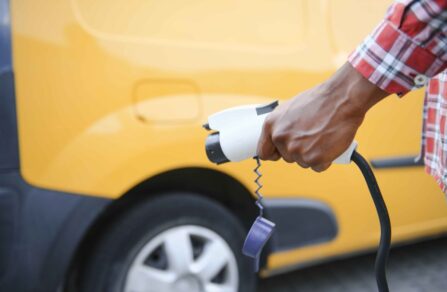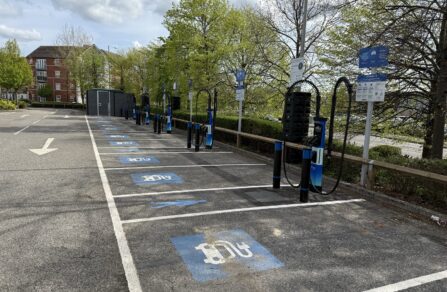
Ask the Experts: How Does Mer Handle the EV Charger Installation Process?
In this series of articles we take the time to sit down with memb...

2021 saw 190,727 new battery-operated vehicles (BEVs) and 114,554 plug-in hybrids (PHEVs) registered, making up 18.5% of the market share that year. At the time, that meant more battery-operated vehicles (BEVs) registered than in the previous 5 years combined.
It was likely that this rate of change would slow down eventually, and although it has done so to some extent, we are still seeing a significant shift towards EVs. As of August 2025, we have already seen 276,635 BEVs registered, making up 21.9% of the total. Across all of 2024, there were 381,970 new EVs registered on British roads.
The shift is happening.
With the introduction of new EV models and factories from manufacturers like VW, BYD, Jaguar, Renault, and countless others, and an ever-expanding public charging network, it’s never been easier or more appealing to own an EV. In fact, with the looming ban on ICE vehicles and a desire to cut carbon emissions, it might be unavoidable before long.
But such rapid market change has brought some clear challenges for the UK. Although the country has generally been able to navigate and address these so far, they may still cause headaches for motorists, the authorities and organisations in the future.
The UK’s public EV charging infrastructure has gone through a massive transformation in the last decade or so, but it still needs investment. As of August 2025, there are:
For context, this figure stood at just 28,460 at the end of 2021!
However, this doesn’t tell the whole story, and the UK’s charging capacity is not always spread evenly across the country. If you live in London, the South East, or near one of the other major population centres, then you’ll probably have plenty of choice. The dreaded range anxiety will be well and truly consigned to the history books.
But… if you live elsewhere, it might be a different story. In fact, as of August 2025, London alone had 26,304 public charge points.
By comparison, that is still more than all of these combined:

With newer EVs accepting increased charging speeds, the need to negate range anxiety fears, and just generally make owning an EV more convenient for people, there’s a clear need for more chargers around the country, especially rapid and ultra-rapid chargers.
In 2024, the EVXperience Report (EVX2) by Zenith identified that 52% of EV motorists would face ‘significant difficulties’ if they had to rely solely on the public network.
Instead of installing more chargers, the answer may lie in installing faster chargers instead. Rapid / ultra-rapid charging has the potential to allow a driver to add over 100 miles of range in under ten minutes – not far off the time it takes to refuel with petrol and diesel. Given that the typical UK car journey is under 9 miles, this would be game-changing for everyone, but especially those who can’t charge at home.
However, one consideration is that faster chargers also need more power.
Read more about the development of rapid and ultra-fast charging networks here.
The National Grid is currently working on estimates that there will be 36 million EVs on the UK’s roads by 2040. But despite concerns about its ability to cope with such pressures, efficiency improvements over the last decade mean energy demand is currently lower than it has been in years – and it’s estimated that even if there was to be an overnight switch to EVs, the increase in overall demand would only be around 10%.
The Grid also estimates that 80% of EV drivers will be using ‘smart charging’ by 2050, which will help balance nearly half of the new energy demands from EVs.
‘Smart charging’ utilises an internet connection to control how much energy an EV takes from the grid and when, ensuring it carries out its charging at the most optimum times – putting less pressure on the grid, and reducing the cost to the driver. Smart chargers can also facilitate dynamic load management – whereby more than one vehicle can charge at the same time within the same network, in an efficient and safe manner. They also empower fleet operators with data on which chargers are being used and by whom.
Read more about smart charging here.

UK government legislation (The Electric Vehicles (Smart Charge Points) Regulations 2021) came into play from June 30th 2022, stipulating that all new chargers installed have smart functionality – with pre-set default charging hours defined that fall outside peak hours (8-11am and 4-10pm).
However, crucially, the legislation states that charge point owners have the option to opt-out once the charger is in place, remove the default charge times and instead set their own, if/when required. Charge points sold alongside, or configured to comply with, a Demand Side Response Agreement (DSR) are also exempt. DSR agreements involve an agreement between an energy user and the grid, to decrease or increase power consumption when required – helping the grid to maintain its 50Hz frequency. Public fast and rapid chargers on motorways and A-roads are also exempt.
In line with legislation, new charge points must also be capable of operating with a randomised power delay of up to 30 minutes. Such a measure will empower local authorities to protect the grid from spikes during periods of high demand.
However, while the grid may be able to cope at a national level, there may still be local limitations that affect the rollout of rapid and ultra-rapid charging infrastructure at scale. In fact, the UK Government itself has recognised the problem:
“Over recent years, connections to the electricity grid have increasingly become a barrier to the deployment of EV charging infrastructure. More generally, the electricity network needs to be transformed at an unprecedented scale and pace to accommodate both new low-carbon generation and increasing demand, including from EV charging. There are 2 main elements to this:
As more and more public, commercial and private charge points are added to the network, efforts will need to be made to ensure the grid can cope. And that’s without considering an overall shift away from fossil fuels and towards renewable or nuclear energy at the national level.
Alongside the increase in the number of charge points across the country, there remains a growing customer expectation for an improved user experience when using them.
At present, drivers can’t always seamlessly roam between different branded chargers or pay as they go with a single charge card. In 2025, when our entire lives revolve around our phones and various interconnected services, charge point operators, energy providers, and manufacturers will need to work together to facilitate a better experience for drivers. This may involve compromise and competitors working together, but ensuring the customer gets the best possible experience is of paramount importance. And this extends to continental Europe as well.
[Add image/video from France Holiday article]
Although EV motoring is largely accepted now, and many of the old complaints and blockers are gone, motorists still expect the convenience they know from their ICE vehicles.
Mer is actively supporting such efforts and is already part of several roaming partnerships. The agreements mean customers can use one charge card or app to charge at thousands of charging points, easing their EV charging experience.

In this series of articles we take the time to sit down with memb...

Discover the UK government’s 2025 new incentives for EV fleets, i...

The changing face of retail parks is helping them stay relevant f...
Sources